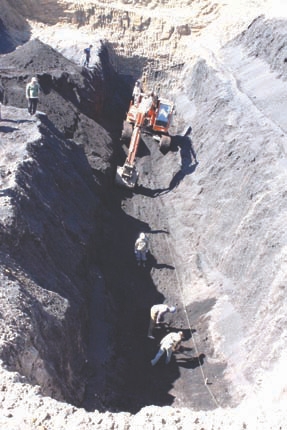Prophecy Resource’s (PCY-V, PCYRF-O) Ulaan Ovoo coal project in Mongolia is expected to be in production this year, so it’s a good thing the company has secured rail loading facilities to transport coal to Russia and beyond.
The company has signed an agreement that allows it to load and transport over 1.5 million tonnes of coal a year through Mongolia’s Sukhbaatar Railroad Station on the Trans-Mongolian Railway.
The rail station is 120 km by road east of Prophecy’s 208.8 million tonne Ulaan Ovoo coal project and just 8 km south of the border between Russia and Mongolia at Naushki, which links with the Trans-Siberian Railroad.
The Trans-Mongolian and Trans- Siberian Railroads share the same track gauge and have been facilitating cross-border trade between Mongolia and Russia since 1949.
The Trans-Siberian Railroad services Russia’s largest coal export facilities at the eastern seaboard ports of Vladivostok and Vanino. From there the coal is exported to coal-hungry nations in Asia such as Japan, Taiwan and South Korea.
“To lock up 1.5 million tonnes on that railway was a good deal,” John Lee, Prophecy’s chairman, told The Northern Miner in a telephone interview from Vancouver. “We’re no longer a stand-alone project that leads to nowhere.”
The Trans-Mongolian Railroad also connects to China’s Erenhot (Erlian) port, which is 1,093 km south of Sukhbaatar and opens Ulaan Ovoo to China, the world’s largest coal consumer. China consumed 3 billion tons of thermal coal last year and plans to double imports of thermal coal to 170 million tons this year.
But Lee says Prophecy will ship the majority of its coal to the Russian seaboard, 3,300 km from the Mongolian border. From Russian ports, the coal can be sent to Japan, Taiwan and Korea.
Lee explains that Prophecy has been in serious discussions with the Koreans, Japanese and the Taiwanese since the start of 2010. These countries previously used to import much of their coal from Indonesia and China, but since 2009, China has gone from being a net exporter of coal to being a net importer. “China is building two power plants a month and at the same time shutting down underground mines that are producing less than half a million tonnes of coal a year,” Lee says.
This year, China is looking to import upwards of 200 million tonnes of coal, roughly the same amount of coal that South Korea, Japan and Taiwan import collectively each year, adds Lee, noting that Prophecy is in discussions with three groups from Russia, south Korea and Japan who are all looking to sign long-term contracts.
Thermal coal of Ulaan Ovoo’s quality currently trades between US$85-US$100 per tonne FOB (free on board) at Vladivostok. Back of the envelope calculations indicate that Prophecy will get decent revenues, particularly in 2011 when it expects to sell 2 million tonnes of coal at US$80 per tonne.
Leighton Asia, a wholly-owned subsidiary of Australia’s Leighton Group, the world’s largest contract miner, has been contracted to produce 250,000 tonnes of coal at Ulaan Ovoo in 2010 and 2 million tonnes of coal in 2011.
Leighton is charging Prophecy US$12 per tonne. That number includes US$5 of mining costs and US$7 of equipment leasing. And it’s headache free. “If their driver is on strike, or their machine breaks down, it’s not our problem,” Lee says.
Prophecy is now finalizing a truck leasing agreement that will enable it to haul the coal from the mine to Sukhbaatar.
Prophecy owns 100% of the Ulaan Ovoo project, which is made up of bituminous (5,204 kcal/kg), low ash (12.46%) and low sulphur (0.40%) thermal coal.
The deposit features a single massive coal seam that is 45-80 metres thick from surface with an average strip ratio of 2:1, which means that the first 50 million tonnes of production will require no washing.
Ulaan Ovoo’s 30-year mining license can be extended by an additional 40 years and the project has met Mongolian environmental approvals.
The Mongolian Ministry of Nature and the Environment approved the project’s Detailed Environmental Impact Assessment and Environmental Protection Plan.
Prophecy filed for its Ulaan Ovoo operating permit in April — the last step before mining can commence — including necessary license, mine plan and environmental approvals. The Vancouver-based company expects to obtain the permit by the summer.
In Toronto at presstime, Prophecy was trading at 59¢ per share. It hit a 52-week low of 4.5¢ per share in July 2009 and a high of $1.19 in March this year.
Lee says Prophecy is undervalued when compared to other coal companies that are trading at about one-time sales revenue.
On that basis, he maintains, Prophecy should be trading at $1.50 per share.
“We’re transitioning from a retail story to an institutional story and it’s going to take a bit of time to finish this transition,” Lee says. “A lot of people are buying and holding. We’re going to reach the point where cheap paper runs out. We’re going to reach an inflection point where there is no more supply of shares at 50¢.”


Be the first to comment on "Prophecy makes headway with Ulaan Ovoo in Mongolia"